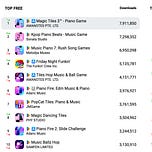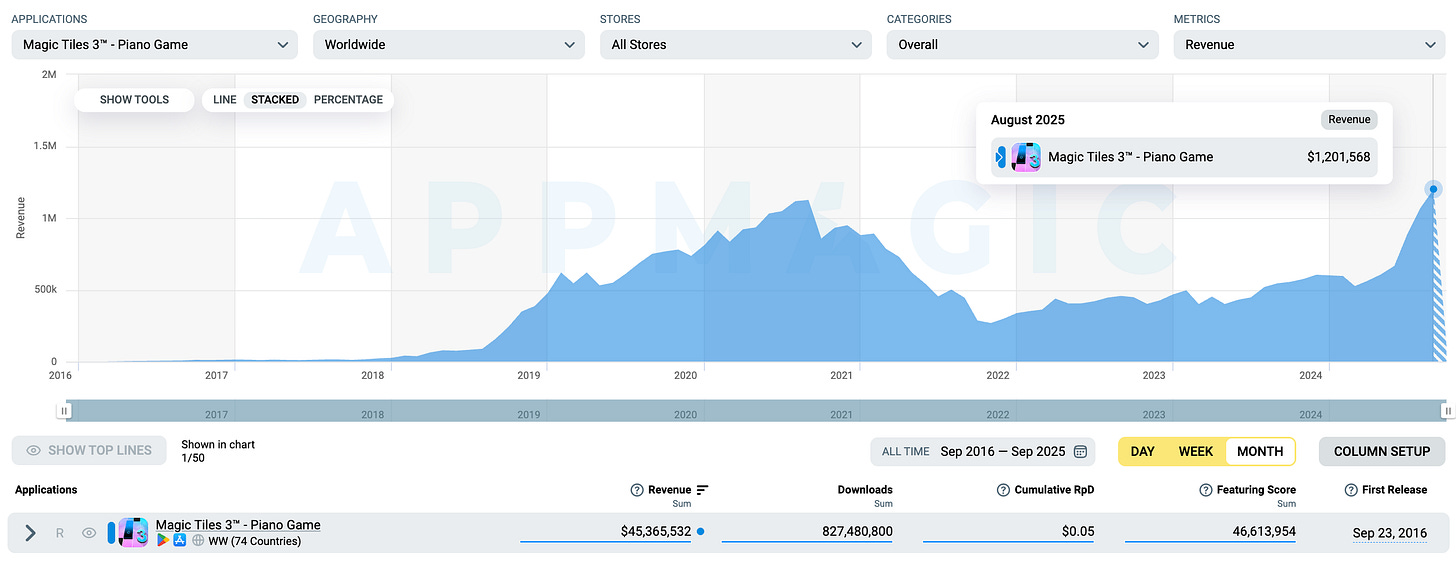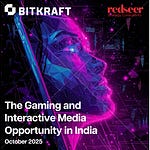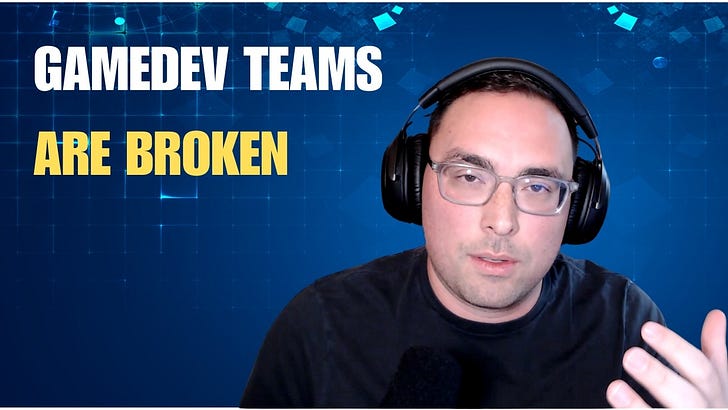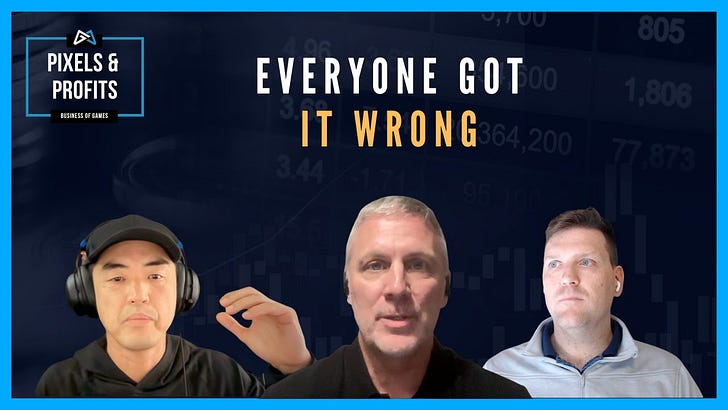Hello GameMakers!
Well, looks like we have a winning format. With that said, I am doing one more tweak to the format. Every Monday I will cover:
Macro: 3 stories impacting the competitive environment in which we operate
Alpha: 2 potential sources of Finding Alpha
Game Dev: 1 lesson learned from getting my ass kicked in game dev
Let me know what you think! 👇👇👇
3. Macro
Top 3 Most Significant Gaming News From Last Week:
Dreamhaven Games Hit by Layoffs (GamesIndustry.biz): Dreamhaven, the studio founded by former Blizzard Entertainment co-founder Mike Morhaime, confirmed it has undergone an unspecified number of layoffs. Despite the cuts, the CEO expressed optimism about the studio's future and the projects currently in development.
Hollow Knight: Silksong Sees Massive Launch Success (IGN): Following its highly anticipated release, Hollow Knight: Silksong immediately surged on Steam, achieving over 453,000 concurrent players within hours of launch. The immense demand, which briefly caused issues on various digital storefronts, placed the game as the third most-played title on Steam and positioned it as potentially one of the biggest indie game launches ever.
Pete Hines slams Xbox Game Pass as "worth jack s***" without proper compensation (Kotaku): Former Bethesda VP Pete Hines delivered a scathing critique of subscription services, arguing Game Pass creates an unsustainable ecosystem that doesn't properly value developers, Kotaku +2 reigniting heated industry debates about subscription models. His comments highlight growing tensions between platform holders and content creators as the industry grapples with profitability challenges.
2. Finding Alpha
Alpha Insight #1: The TikTok Music Arbitrage
Magic Tiles 3, a mobile rhythm game from Vietnamese developer Amanotes, just demonstrated a masterclass in platform-native marketing. After years of steady but unremarkable performance, the game suddenly exploded to become the #1 rhythm game by downloads in August 2025, with revenue hitting all-time highs.
Their secret weapon? Ditching expensive licensed music for TikTok's viral "brain rot" songs.
The Strategic Pivot:
Abandoned traditional music licensing (which can cost millions at scale)
Embraced TikTok's Commercial Music Library of 1M+ royalty-free tracks
Featured viral sensations like "Passo Bem Solto" (115-116 BPM Brazilian funk) and "Sigma Boy" (82.7M TikTok posts)
The Results:
30% better return on ad spend (ROAS)
41% higher user lifetime value
Zero licensing complications or DMCA risks
Algorithm boost from TikTok promoting content with trending sounds
Key Takeaways for Developers:
Platform-native content consistently outperforms generic assets
Audio is essential on TikTok - 88% of users expect sound, and audio-enabled content is 73% more likely to stop scrollers
Sometimes the "cheaper" option (royalty-free music) is actually the strategically superior choice
First-mover advantage is real - Omanotes capitalized while competitors stuck to traditional licensing
Alpha Insight #2: The Great Western Game Development Divergence
While industry headlines scream about studio closures and AAA failures, a quiet revolution is happening. Small Western teams - sometimes just one person - are generating revenue that rivals major studio releases.
The data tells a story that contradicts the doom-and-gloom narrative:
Lethal Company
Developer: 1 person (Zeekers)
Budget: Near zero (personal expenses + asset store)
Results: 10M+ units sold, $70M net revenue after Steam's cut
Peak concurrent: 240,000 players
Marketing spend: $0 (pure viral/streamer growth)
Project Zomboid
Developer: ~10 people (The Indie Stone)
Development model: 13 years of early access
Results: 10-20M units sold, hundreds of millions in lifetime revenue
Philosophy: "The Drip" - steady-state sales funding everything
User reviews: 94% positive after 13 years
No Man's Sky
Team size: 15 at launch, ~40-50 today
Business model: Buy once, infinite free updates
2022 profit: £40.5M
Transformation: From industry's most hated to most beloved
Strategy: Chose legacy over short-term profit extraction
Phasmophobia
Started with: 1 developer
Current team: 5 people
Results: 25M+ copies, $350-500M revenue
Peak concurrent: 450,000 players
Schedule I (Lethal Company)
Solo developer using AI tools for visuals
8M+ units sold
Peak concurrent: 450,000 players
Marketing: $0 (TikTok viral)
The Pattern Behind the Success
These aren't outliers anymore - they represent a fundamental shift in what works:
1. Authenticity Over Polish
Players forgive janky graphics for genuine gameplay
Community interaction matters more than AAA production values
Systems transparency builds trust
2. Lean Operations Enable Risk-Taking
60% profit margins (see Tibia MMO) vs AAA's razor-thin margins
No corporate overhead means faster iteration
Direct player feedback loops
3. Platform-Native Growth
TikTok and streamer virality replaces traditional marketing
Proximity chat in Lethal Company created more marketing value than any trailer
Social features designed for content creation
4. Time Horizons Matter
Project Zomboid: 13 years of development
No Man's Sky: 8 years of free updates
Building for a much longer time horizon
Strategic Implications
For AAA Publishers:
The $300M blockbuster model is broken
Consider autonomous small teams with $20 products
Look at Helldivers 2: AA budget, AAA impact
For Indie Developers:
Tools have never been more accessible
Audiences actively seek alternatives to AAA
Serve niches with passion, don't chase trends
Consider longer development cycles with community involvement
For Investors:
ROI potential in lean teams dwarfs bloated studios
Look for authentic voices, not polished pitches
Platform-native growth strategies are the new normal
The alpha isn't in competing with AAA on their terms. It's in recognizing that the rules have fundamentally changed. While corporate studios optimize for quarterly earnings, a new generation of developers is optimizing for sustainable communities and long-term value creation. The market is rewarding them accordingly.
1. Game Dev Lessons: On Decision Making
Behind every failed game launch and studio closure lies a trail of poor decisions. After analyzing patterns across the industry, a clear picture emerges: the way game studios make decisions is fundamentally broken, and it's costing us billions.
The Macro Problem: Who Gets to Green-Light a Game?
There's a toxic relationship between budget size and decision-maker competence in Western AAA development. As budgets scale from $1M to $300M+, decision-making authority moves up the corporate ladder - and further away from people who actually understand games.
The cruel irony? The people controlling the largest budgets often don’t actually know games or their audience well. They demand data to justify every decision, but the most successful games of the past decade - from Minecraft to Lethal Company - would have failed any data-driven approval process.
Could anyone have predicted the successes outlined by the small indies in the Alpha section through traditional greenlight processes?
The answer is no.
The Micro Problem: The "Blind Men and the Elephant"
At the studio level, critical decisions about features, hiring, and design are frequently made "on the fly" without rigorous contemplation. This is especially dangerous for what Jeff Bezos calls "one-way door decisions"—costly choices that are difficult or impossible to revert.
This flaw is compounded by departmental silos. An artist approaches a problem with one objective, an engineer another, and a product manager a third. Like the parable of the blind men and the elephant, each person accurately describes their piece of the puzzle while completely misinterpreting the whole.
The solution requires a more structured approach: using logic trees, first-principles thinking, and decision analysis to map out all associated issues, knock-on effects, and risks before committing. In an industry filled with brilliant creatives, the failure to implement basic critical thinking frameworks leads to half-assed decisions and, ultimately, failed projects.
The path forward requires more than just smaller budgets; it demands a shift in philosophy, empowering creators and re-instilling analytical rigor into the development process.

